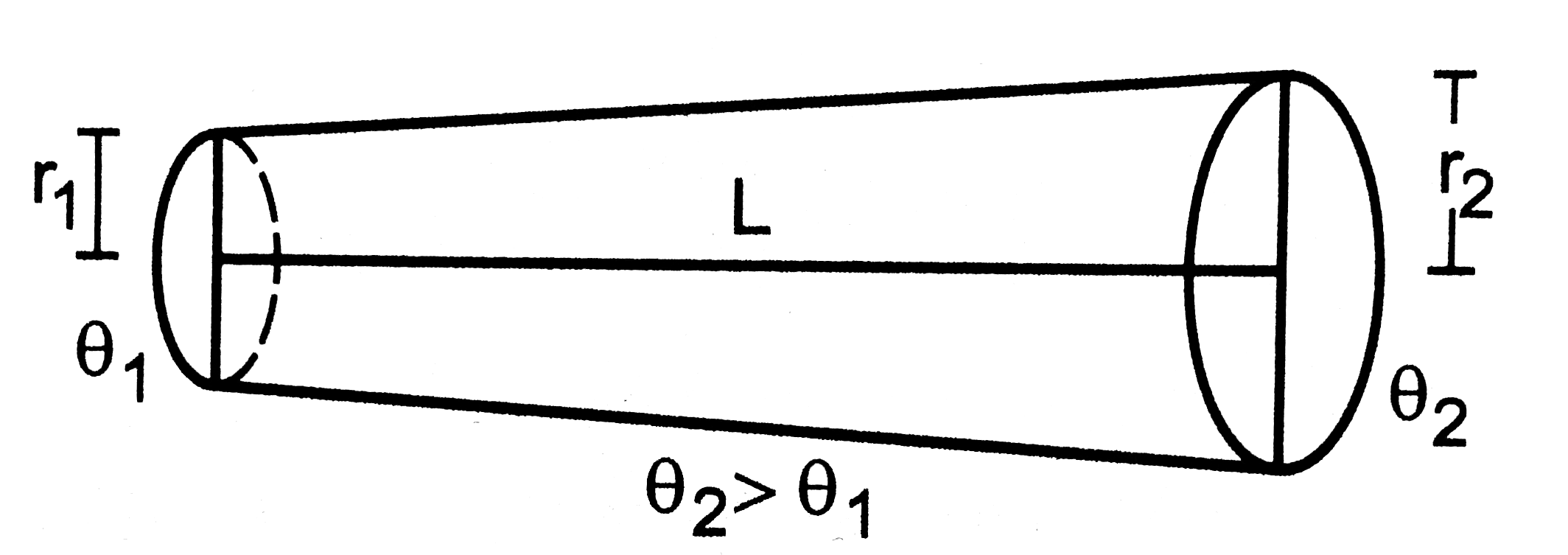Heat is flowing through a rod of length 25.0cm having cross-sectional area 8.80cm2. The coefficient of thermal conductivity for the material of the rod is K=9.2×10−2kcals−1m−1.∘C−1. The Temperatures of the ends of the rod are 125∘C and 0∘C in the steady state. Calculate (i) temeprature gradient in the rod (ii) temperature of a point at a distance of 10.0cm from the hot end and (iii) rate of flow of heat.
To solve the problem step by step, we will calculate the temperature gradient, the temperature at a specific point, and the rate of heat flow through the rod.
Given Data:
- Length of the rod, L=25.0cm=0.25m
- Cross-sectional area, A=8.80cm2=8.80×10−4m2
- Coefficient of thermal conductivity, K=9.2×10−2kcal/s/m/°C=92cal/s/m/°C
- Temperature at one end, T1=125°C
- Temperature at the other end, T2=0°C
Step 1: Calculate the Temperature Gradient
The temperature gradient (dTdx) is given by the formula:
dTdx=T1−T2L
Substituting the values:
dTdx=125°C−0°C0.25m=1250.25=500°C/m
Step 2: Calculate the Temperature at a Point 10 cm from the Hot End
To find the temperature at a point 10 cm from the hot end, we first find the distance from the cold end, which is:
Distance from cold end=L−10cm=25cm−10cm=15cm=0.15m
Now, we can calculate the temperature at this point using:
T=T2+(dTdx×Distance from cold end)
Substituting the values:
T=0°C+(500°C/m×0.15m)=0+75=75°C
Step 3: Calculate the Rate of Heat Flow
The rate of heat flow (dQdt) can be calculated using Fourier's law of heat conduction:
dQdt=K⋅A⋅dTdx
Substituting the values:
dQdt=92cal/s/m/°C⋅8.80×10−4m2⋅500°C/m
Calculating:
dQdt=92⋅8.80×10−4⋅500
dQdt=92⋅0.00088⋅500=40.48cal/s
Final Answers:
1. Temperature Gradient: 500°C/m
2. Temperature at 10 cm from the hot end: 75°C
3. Rate of Heat Flow: 40.48cal/s
- Length of the rod, L=25.0cm=0.25m
- Cross-sectional area, A=8.80cm2=8.80×10−4m2
- Coefficient of thermal conductivity, K=9.2×10−2kcal/s/m/°C=92cal/s/m/°C
- Temperature at one end, T1=125°C
- Temperature at the other end, T2=0°C
The temperature gradient (dTdx) is given by the formula:
dTdx=T1−T2L
Substituting the values:
dTdx=125°C−0°C0.25m=1250.25=500°C/m
To find the temperature at a point 10 cm from the hot end, we first find the distance from the cold end, which is:
Distance from cold end=L−10cm=25cm−10cm=15cm=0.15m
Now, we can calculate the temperature at this point using:
T=T2+(dTdx×Distance from cold end)
Substituting the values:
T=0°C+(500°C/m×0.15m)=0+75=75°C
The rate of heat flow (dQdt) can be calculated using Fourier's law of heat conduction:
dQdt=K⋅A⋅dTdx
Substituting the values:
dQdt=92cal/s/m/°C⋅8.80×10−4m2⋅500°C/m
Calculating:
dQdt=92⋅8.80×10−4⋅500
dQdt=92⋅0.00088⋅500=40.48cal/s
1. Temperature Gradient: 500°C/m
2. Temperature at 10 cm from the hot end: 75°C
3. Rate of Heat Flow: 40.48cal/s
Topper's Solved these Questions
- THERMODYNAMICSBOOK - SL ARORACHAPTER - THERMODYNAMICSEXERCISE - Problems from competitive examinations
22 Videos
- THERMODYNAMICSBOOK - SL ARORACHAPTER - THERMODYNAMICSEXERCISE - Problems for self practice
97 Videos
- Thermal Properties of MatterBOOK - SL ARORACHAPTER - Thermal Properties of MatterEXERCISE - Exercise
449 Videos
- Units and MeasurementsBOOK - SL ARORACHAPTER - Units and MeasurementsEXERCISE - Exercise
499 Videos
Similar Questions
Find the rate of heat flow through a cross section of the rod shown in figure (θ2>θ1 . Thermal conductivity of the material of the rod is K.

View SolutionA rod of length1m having cross sections area 0.75m^(2), conducts heat at 6000J/sec.Then the temperature difference across the rod isK=200Wm^(-1)k^(-1)
View Solution
Knowledge Check
The heat is flowing through a rod of length 50 cm and area of cross-section 5cm2 . Its ends are respectively at 25∘C and 125∘C . The coefficient of thermal conductivity of the material of the rod is 0.092kcal/m×s×.∘C . The temperature gradient in the rod is
A2∘C/cmB2∘C/mC20∘C/mD20∘C/cmIn a steady state of thermal conduction, temperature of the ends A and B of a 20 cm long rod are 100∘C and 0∘C respectively. What will be the temperature of the rod at a point at a distance of 6 cm from the end A of the rod
A−30∘CB70∘CC5∘CDNone of the aboveThe temperature of hot and cold end of a 20 cm long rod in thermal steady state are at 100∘C and 20∘C respectively. Temperature at the centre of the rod is
A50∘CB60∘CC40∘CD30∘C
The temperature of the two ends A and B of a rod of length 25cm and circular cross section are 100∘C and 0∘C respectively In the steady state, find the temperature at a point 10cm from the end B (ifnore loss of heat from curved surface of the body) ?
View SolutionFind the thermal resistance of an aluminium rod of length 20cm and area of cross section 1cm2 . The heat current is along the length of the rod. Thermal conductivity of aluminium =200Wm−1K−1 .
View SolutionIf the coefficient of conductivity of aluminium is 0.5calcm−1s−1.∘C−1, then the other to conductor 10cals−1cm−2 in the steady state, the temperature gradient in aluminium must be
View SolutionThe end A of rod AB of length 1 m is maintained at 80∘C and the end B at 0∘C. The temperature at a distance of 60 cm from the end A is
View SolutionThe temperature gradient in a rod of 0.5m length is 80∘C/m. It the temperature of hotter end of the rod is 30∘C, then the temperature of the cooler end is
View Solution
